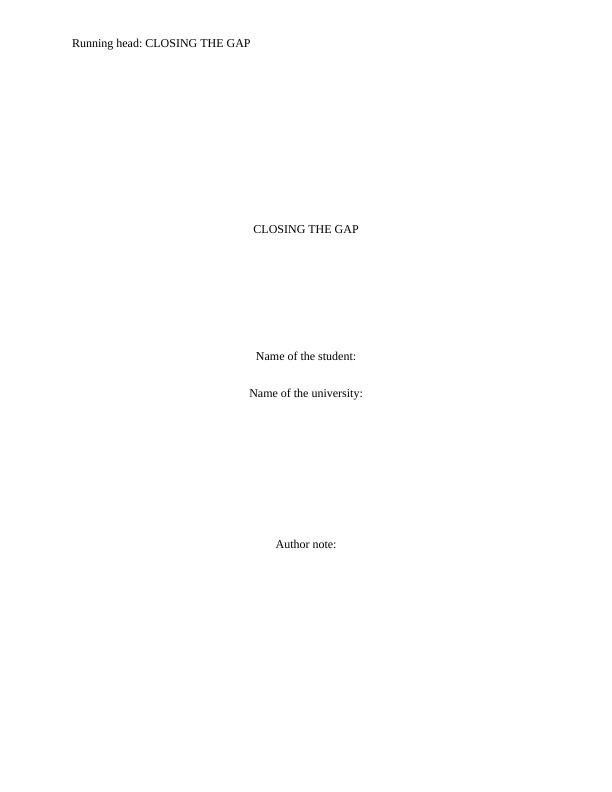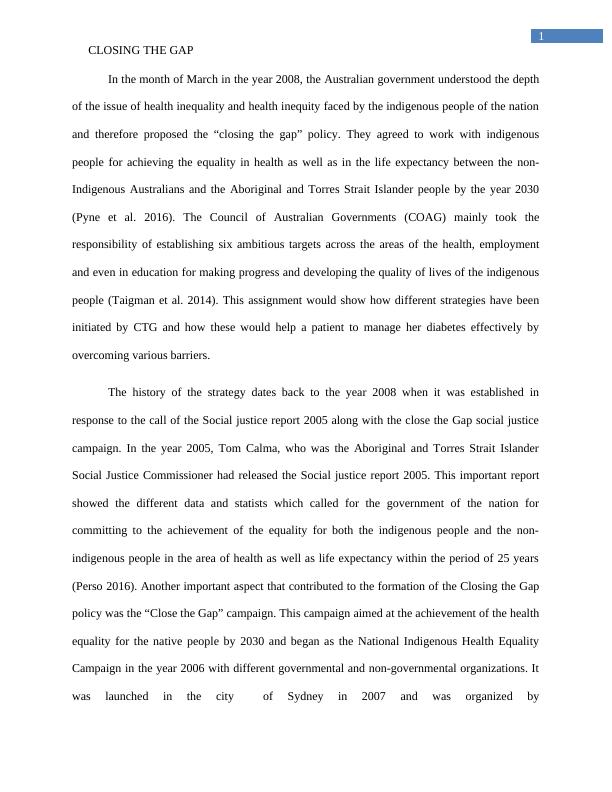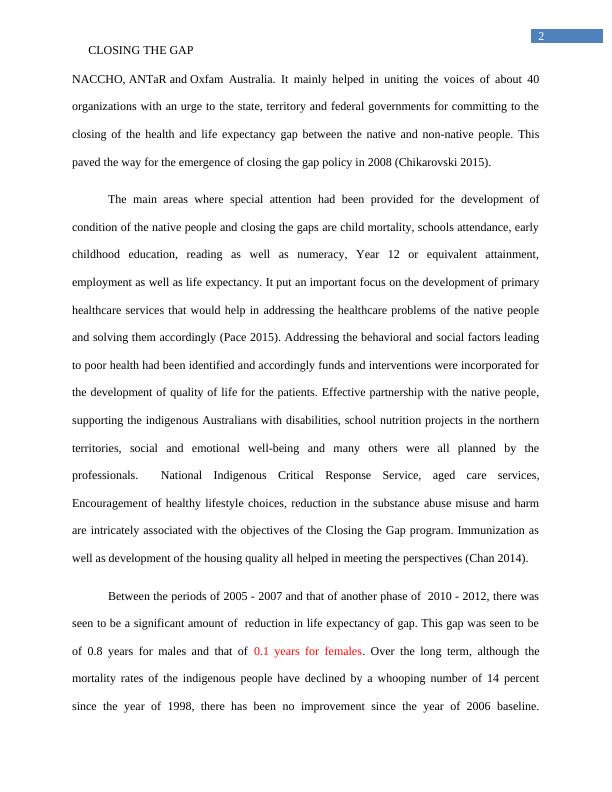Closing the Gap: Strategies and Initiatives for Indigenous Health Equity
Added on 2023-06-10
10 Pages2692 Words220 Views
Running head: CLOSING THE GAP
CLOSING THE GAP
Name of the student:
Name of the university:
Author note:
CLOSING THE GAP
Name of the student:
Name of the university:
Author note:

1
CLOSING THE GAP
In the month of March in the year 2008, the Australian government understood the depth
of the issue of health inequality and health inequity faced by the indigenous people of the nation
and therefore proposed the “closing the gap” policy. They agreed to work with indigenous
people for achieving the equality in health as well as in the life expectancy between the non-
Indigenous Australians and the Aboriginal and Torres Strait Islander people by the year 2030
(Pyne et al. 2016). The Council of Australian Governments (COAG) mainly took the
responsibility of establishing six ambitious targets across the areas of the health, employment
and even in education for making progress and developing the quality of lives of the indigenous
people (Taigman et al. 2014). This assignment would show how different strategies have been
initiated by CTG and how these would help a patient to manage her diabetes effectively by
overcoming various barriers.
The history of the strategy dates back to the year 2008 when it was established in
response to the call of the Social justice report 2005 along with the close the Gap social justice
campaign. In the year 2005, Tom Calma, who was the Aboriginal and Torres Strait Islander
Social Justice Commissioner had released the Social justice report 2005. This important report
showed the different data and statists which called for the government of the nation for
committing to the achievement of the equality for both the indigenous people and the non-
indigenous people in the area of health as well as life expectancy within the period of 25 years
(Perso 2016). Another important aspect that contributed to the formation of the Closing the Gap
policy was the “Close the Gap” campaign. This campaign aimed at the achievement of the health
equality for the native people by 2030 and began as the National Indigenous Health Equality
Campaign in the year 2006 with different governmental and non-governmental organizations. It
was launched in the city of Sydney in 2007 and was organized by
CLOSING THE GAP
In the month of March in the year 2008, the Australian government understood the depth
of the issue of health inequality and health inequity faced by the indigenous people of the nation
and therefore proposed the “closing the gap” policy. They agreed to work with indigenous
people for achieving the equality in health as well as in the life expectancy between the non-
Indigenous Australians and the Aboriginal and Torres Strait Islander people by the year 2030
(Pyne et al. 2016). The Council of Australian Governments (COAG) mainly took the
responsibility of establishing six ambitious targets across the areas of the health, employment
and even in education for making progress and developing the quality of lives of the indigenous
people (Taigman et al. 2014). This assignment would show how different strategies have been
initiated by CTG and how these would help a patient to manage her diabetes effectively by
overcoming various barriers.
The history of the strategy dates back to the year 2008 when it was established in
response to the call of the Social justice report 2005 along with the close the Gap social justice
campaign. In the year 2005, Tom Calma, who was the Aboriginal and Torres Strait Islander
Social Justice Commissioner had released the Social justice report 2005. This important report
showed the different data and statists which called for the government of the nation for
committing to the achievement of the equality for both the indigenous people and the non-
indigenous people in the area of health as well as life expectancy within the period of 25 years
(Perso 2016). Another important aspect that contributed to the formation of the Closing the Gap
policy was the “Close the Gap” campaign. This campaign aimed at the achievement of the health
equality for the native people by 2030 and began as the National Indigenous Health Equality
Campaign in the year 2006 with different governmental and non-governmental organizations. It
was launched in the city of Sydney in 2007 and was organized by

2
CLOSING THE GAP
NACCHO, ANTaR and Oxfam Australia. It mainly helped in uniting the voices of about 40
organizations with an urge to the state, territory and federal governments for committing to the
closing of the health and life expectancy gap between the native and non-native people. This
paved the way for the emergence of closing the gap policy in 2008 (Chikarovski 2015).
The main areas where special attention had been provided for the development of
condition of the native people and closing the gaps are child mortality, schools attendance, early
childhood education, reading as well as numeracy, Year 12 or equivalent attainment,
employment as well as life expectancy. It put an important focus on the development of primary
healthcare services that would help in addressing the healthcare problems of the native people
and solving them accordingly (Pace 2015). Addressing the behavioral and social factors leading
to poor health had been identified and accordingly funds and interventions were incorporated for
the development of quality of life for the patients. Effective partnership with the native people,
supporting the indigenous Australians with disabilities, school nutrition projects in the northern
territories, social and emotional well-being and many others were all planned by the
professionals. National Indigenous Critical Response Service, aged care services,
Encouragement of healthy lifestyle choices, reduction in the substance abuse misuse and harm
are intricately associated with the objectives of the Closing the Gap program. Immunization as
well as development of the housing quality all helped in meeting the perspectives (Chan 2014).
Between the periods of 2005 - 2007 and that of another phase of 2010 - 2012, there was
seen to be a significant amount of reduction in life expectancy of gap. This gap was seen to be
of 0.8 years for males and that of 0.1 years for females. Over the long term, although the
mortality rates of the indigenous people have declined by a whooping number of 14 percent
since the year of 1998, there has been no improvement since the year of 2006 baseline.
CLOSING THE GAP
NACCHO, ANTaR and Oxfam Australia. It mainly helped in uniting the voices of about 40
organizations with an urge to the state, territory and federal governments for committing to the
closing of the health and life expectancy gap between the native and non-native people. This
paved the way for the emergence of closing the gap policy in 2008 (Chikarovski 2015).
The main areas where special attention had been provided for the development of
condition of the native people and closing the gaps are child mortality, schools attendance, early
childhood education, reading as well as numeracy, Year 12 or equivalent attainment,
employment as well as life expectancy. It put an important focus on the development of primary
healthcare services that would help in addressing the healthcare problems of the native people
and solving them accordingly (Pace 2015). Addressing the behavioral and social factors leading
to poor health had been identified and accordingly funds and interventions were incorporated for
the development of quality of life for the patients. Effective partnership with the native people,
supporting the indigenous Australians with disabilities, school nutrition projects in the northern
territories, social and emotional well-being and many others were all planned by the
professionals. National Indigenous Critical Response Service, aged care services,
Encouragement of healthy lifestyle choices, reduction in the substance abuse misuse and harm
are intricately associated with the objectives of the Closing the Gap program. Immunization as
well as development of the housing quality all helped in meeting the perspectives (Chan 2014).
Between the periods of 2005 - 2007 and that of another phase of 2010 - 2012, there was
seen to be a significant amount of reduction in life expectancy of gap. This gap was seen to be
of 0.8 years for males and that of 0.1 years for females. Over the long term, although the
mortality rates of the indigenous people have declined by a whooping number of 14 percent
since the year of 1998, there has been no improvement since the year of 2006 baseline.

End of preview
Want to access all the pages? Upload your documents or become a member.
Related Documents
Indigenous Population Health Care in Australialg...
|7
|2127
|87
Close the Gap Strategy and Government's Role in Bridging the Gap by 2030lg...
|9
|2169
|96
Indigenous Health and Wellbeing: Closing the Gap Policy and its Significancelg...
|9
|2177
|307
Aboriginal Nursing Assignment - NUR1201lg...
|10
|2718
|56
PUBH6000: Social, Behavioural and Cultural Factors in Publiclg...
|9
|2074
|26
Closing the Gap Policy and its Significance to Indigenous Australianslg...
|9
|2301
|364
